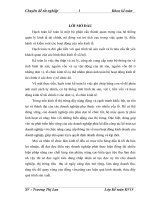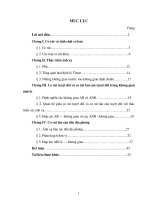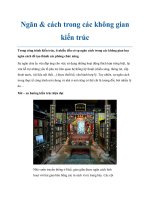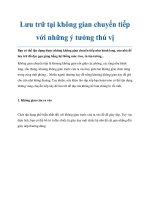Mở rộng phạm trù các không gian mở hữu hạn chiều thành hệ đầy đủ. pot
Bạn đang xem bản rút gọn của tài liệu. Xem và tải ngay bản đầy đủ của tài liệu tại đây (1.73 MB, 4 trang )
T?-p chi Tin hoc va
f)i'eu
khi€n hqc, T. 17, S.2 (2001),
35-38
COMPLETION OF THE CATEGORY OF FINITE-DIMENSIONAL
FUZZY SPACES
NGUYEN NHUY, PHAM QUANG TRINH
and
VU THI HONG THANH
Abstract. In this paper we introduce a method to expand the category
1
of all finite-dimensional fuzzy
spaces associated with finite-dimensional Chu spaces into a complete system.
Torn tli t. Ba.i nay tiep tuc nghien
CUll
pham tr u cac kh orig gian- mo' hiru han chie u d a dU'<TCde c~p den
trong [7] va [8].
Nhtr
da diro'c chirng minh trong [7], ph arn tru
1
cac khong gian
me:
hii'u h an chie u lien ket
vO'icac khong gian Chu hiru han chieu
111.
mot h~ thong tiro'ng du-o'ng, tuy nhien , 1 khorig dong doi vo'i ph ep
lay tich cheo nen no khorig
111.
mot h~ thong day duo Trong b ai nay, chiing toi du'a ra mot
phiro'ng
ph ap mo-
r9ng pharn tru
1
th anh mot
M
tliong day duo
Dg
lam dieu do, chung toi xay dung mot ph am tru n-t~p ho-p
doi ngiu
1*
chtra
1
nh u' mot ph am tru con, trong do
1*
la mot h~ thong day duo
1. INTRODUCTION
It is shows in
[71
that, the category
1
of all finite-dimensional fuzzy spaces associated with
finite-dimensional Chu spaces is an equivalent system. Unfortunately, 1 is not closed under the cross
product, therefore 1 is not a complete system. In this paper we introduce a method to expand the
category
1
into a complete system, that is, we construct a "dual" n-set category
1*
containing
1
as
a subcategory, where
1*
is a complete system.
2. FINITE-DIMENSIONAL *-FUZZY SPACES
AND THE *-FUZZY FUNCTOR
By
n-set
we mean a cartesian product
X =
11;~1
Xi.
Let S denote the n-set category, when
the category S
*
is defined as follows:
1.
Objects of
S*
are morphisms in
S.
2. If
a :
X =
11;~1
X;
-t
Y =
11;~1
Y;
and
a
'
:
objects of
S*,
then a morphism
<p : a
-t
a
'
from
a
to
ip :
Y
=
117=1
Y
i
-t
X'
=
117=1
X:.
Let
a : X =
11
n
X·
-t
Y =
11
n
y:
a
'
: X' =
11
n
X'
-t
Y' =
11
n
Y'
and
a" . X" =
t=1
t
t=l
t)
1.=1
t
t=1
t •
11;~1
X:'
-t
Y" =
11;~1
y';"
be objects in
S*, <p: a
-t
a
'
and
<p' : a
'
-t
a"
be morphisms of
S*
(i.e.,
ip : Y =
117=1
Y;
-t
X' =
117=1
X:
and
<p' : Y' =
117=1
Y/
-t
X" =
11;~1
X:').
Then
composition
of
<p
and
ip",
denoted by
<p'
*
<p,
is given by
X
I
11n
X' Y'
11
n
Y'
=
i=1
i -t
=
i=1
i
are two
a
'
in
S
*
is a map (in the n-set category)
<p'
*
<p= <p'a'<p: a
-t
a".
It is easy to check that with the above definition
S
*
is a category.
For a given set
X
=
11;'=1
Xi,
let
X*
=
[0,
llx
denote collection of all fuzzy sets of
X.
For a map
a : X
=
11;~1
Xi
-t
Y =
11;~1
Y;
we define the conjugate
a* : Y*
-t
X*
of
a
by the formula
a*(a)(x) = a(a(x))
for
x
E
X
and
a
E
Y*.
It is easy to see that
(.Bar
=
a*.B*
for every
a : X
-t
Y
and.B :
Y
-t
Z.
36
NGUYEN NHUY, PHAM qUANG TRINH, VU THI HONG THANH
Now for
a :
X
=
rr=l Xi
t
Y
=
TI~'=1
Y;
we define
F*(a)
=
(TI7=1
Xi, fa, Y*),
where
Y*
denotes
the collection of all fuzzy sets of
Y
=
TI~~1
y;,
and
fa :
TI7=1Xi
X
Y*
t
[0,1] is given by
fa (Xl, X2,··· ,X
n,
a)
=
a(a(xI' X2, ,xn))
for every
(Xl,
X2, , Xn, a)
E
TI7=1Xi
X
Y*.
The (n+1)-dimensional Chu space
F*(a)
=
(TI7=1
Xi, fa, Y*)
is called the
(n+l)-dimensional
*-fuzzy space associated with the map a :
X
=
TI7=1Xi
t
Y
=
TI~1
Y;. The category of all
(n+1)-dimensional *-fuzzy spaces associated with maps in the
n-set
category
S
is called the
(n+l)-
dimensional *-fuzzy category
and denoted by
1*.
3.
RESULTS
At first, we will show that the
(n+
1)-dimensional *-fuzzy category
1*
defined above contains
the category
1
as a subcategory. In fact, we have the following theorem.
Theorem 1.
Any (n+l)-dimensional fuzzy space is a (n+l)-dimensional *-fuzzy space.
Proof.
If
F(X)
=
(TI7=IX
i
,fx',X*)
then clearly that
F(X)
=
F*(lx)
is a (n+1)-dimensional
*-fuzzy space.
\
Theorem 2.
1*
is a complete system.
Proof.
Assume that
<I>
=
(TI7=1
<Pi,1f;) : F*(a)
=
(TI7=1
Xi, fa, Y*)
t
F*(a')
=
(TI7~1
X:, fa', Y'*)
is a (n+1)-Chu morphism, where
F*(a)
and
F*(a')
are (n+1)-dimensional *-fuzzy spaces associated
with the maps
a
=
TI~'=1
cc; :
X
=
TI:~1 Xi
t
Y
=
TI7=1
Y;
and
a'
=
TI~'=1
a; :
X'
=
TI7=1X;
t
Y'
TIn
Y' .
1 P . (3 ,
TIn , X TIn X
Y'
TIn
Y'
=
i=l i'
respective
y.
utt mg
=
a <P
=
i=l
ai<Pi:
=
i=l
i
t
=
i=l i'
we
get the cross product
C
=
(TI7=1
Xi, fa
X <I>
fa', Y'*),
which is a (n+1)-dimensional *-fuzzy space
associated with the map
(3
=
TI7=
I
a; <Pi·
In fact, for every
(X
I,
,X
n
, b)
E
TI7=
I
Xi
X
Y'*,
we have
(to X 'I'
fa' )(XI,'" ,Xn, b)
=
fa' (<pdxd,··· ,<Pn(xn), b)
=
b(a~<pI(xd,··· ,a~<Pn(Xn))
=
fa''P(xI,'" ,xn,b)
=
f{1(xI,'" ,xn,b).
Thus, the category
1*
is closed under the cross product. Therefore the theorem is proved.
Theorem 3.
F* S*
t
1*
is a covariant functor.
Proof.
For a morphism
<P
=
TI7=1
<Pi a
=
TI:'=1
ai
t
a'
=
TI7=1
a;,
with
a,a'
E
S*,
we define
n
F*(<p)
=
(II
<Piai, <p*a'*)
i=l
where
ip"
and
a'*
are conjugated of
<P
=
TI7=1
<Pi
and
a'
=
TI7=1
a;,
respectively, that is
n
<p*(a)(YI"" ,Yn)
=
a(<pdyd,··· ,<Pn(Yn))
for every
(Yl,'" ,Yn)
E
II
Y;
and
a
E
X'*
i=1
and
n
a/*(b)(x~, ,x~)
=
b(a~ (x~), ,a~(x~))
for every
(x~, ,x~)
E
II
X:
and
bE
y'*.
i=l
We claim that
F*(<p) : F*(a)
=
(TI7=IX,fo,Y*)
t
F*(a')
=
(TI7=IX:,fa"Y'*)
is a
(n+1)-
dimensional Chu morphism. That is, the following diagram commutes:
COMPLETION OF THE CATEGORY OF FINITE-DIMENSIONAL FUZZY SPACES
37
[[';=1
Xi
X
v':
(L,'P*a'*)
1
('Po,ly,.)
IT
n
x: ,
>1
i=1
i
X
Y *
In fact, for every
(Xl,
,X
n
)
E
IT;';"
1
Xi
and
bEY'*,
we have
fa(x1,'" ,xn,<p*a/*(b))
=
<p*a'*(b)(adx1),'" ,an(xn))
=
(a'<p)*(b)(adxd,··· ,an(xn))
=
b(a~ <P1adxd, ,a~<Pnan(xn))
=
fa' (<pa(x), b)
Consequently the above diagram commutes.
Hence
F*(<p)
=
(IT7=1
<Piai, <p*a'*)
is a (n+1)-Chu morphism.
Now we will show that
F*
preserves the composition. In fact, let
n n
n
n
n n
a'
=
II
a: :
X' =
II
X:
->
Y' =
II
Y/
i=1 i=1 i=1
i=
1
n=l
i=1
and
n n n
II -
II
II.
X" -
II
X"
yll -
II
yll
Q -
Ui' -
i
+ -
i
i=1
i=1
i=1
be objects in the category
S*.
Let
<p
=
IT7=1
<Pi:
a
=
IT7=1
ai
->
a'
=
IT7=1
a:
and
<p'
=
IT7=1
<p~:
I
IT
n
I II
IT
n
II
b hi .
S* (.
IT
n
y
IT
n
y.
X'
a
=
i=1
a
i
->
a
=
i=1
a
i
e morp Isms In l.e.,
<p
=
i=1 <Pi:
=
i=;1
i
->
=
rr=1
X:
and
<p'
=
IT7=1
<p; : Y'
=
IT7=1
Y./
->
X"
=
IT7=1
X:
'
are maps in the n-set category). By
the definition we have
<p'
*
<p
=
<p'a'<p
=
IT7=1
<p~a:<pi'
Therefore
F
* (' ) ('
I (' I )
* "*)
<p
*
<p
=
<p
a
spec,
<p
a
<p
a
(
I I
*
'*
'*
11*)
= <p
a
<pa, <p
a
<p
a
=
F*(<p')F*(<p).
Consequently
F*
preserves the composition, and hence
F* : S*
->
1*
is a covariant functor.
The functor
F* : S*
->
1*
is called
(n+l)-dimensional *-fuzzy functor.
Acknowledgernerrt.
The authors are thankful to N. T. Hung of New Mexico for his comments
during the prepar ation of this paper.
REFERENCES
[1] Barr M.,
*
-Autonomous categories,
Lecture Notes in Mathematics,
#752, Springer-Verlag;
Electronic Notes in Theorestical Computer Science,
1979.
[2] Barry Mitchell,
Theory of Categories,
NewYork and London, 1965.
[3] Barwise
J.
and Seligman
J.,
Information Flow, The Logic of Distributed Systems,
Cambridge
Univ. Pess, 1977.
[4] Gupta V., "Chu spaces: a model of concurrency", Ph.D. thesis, Stanford Univ., Available at
ftp:// boole.stanford.edu/pub/gupthes.ps.Z., 1994.
[5] Nguyen H. T. and Walker E.,
A First Course in Fuzzy Logic,
Boca Raton, FL: CRe, 1997 (2nd
ed., 1999).
[6] Nguyen H. T. and Sugeno M.,
Fuzzy Systems: Modeling and Control,
Kluwer Academic, 1998.
38
NGUYEN NHUY, PHAM QUANG TRINH, VU THI HONG THANH
[7] Nguyen
Nhuy,
Ph am Quang Trinh, and Vu Hong Thanh, Finite-dinesional Chu space,
Journal
of Computer Science and Cybernetics
15
(4)
(1999).
[8] Nguyen Nhuy and Vu Hong Thanh, Finite-dimensional Chu space, Fuzzy space and the game
Invariance Theorem, to apper in
Journal of Computer Science and Cybernetics.
[9] Paradopoulos B. K. and Syropoulos A., Fuzzy sets and fuzzy relational structures as Chu spaces,
Proceedings of the First International Workshop on Current Trends and Developments of Fuzzy
Logic,
Thessaloniki, Greece, Oct. 16-20, 1998;
Electronic Notes in Theoretical Computer Science
(1998).
[10] Pratt V. R., Type as procsses, via Chu spaces,
Electronic Notes in Theoretical Computer Science
7
(1997).
[11] Pratt V. R., Chu spaces as a sematic bridge between linear logic and mathematics,
Electronic
Notes in Theoretical Computer Science
12
(1998).
Received August
11,
2000
Department of Information Technology,
Vinh University, Nqhe An, Vietnam.









